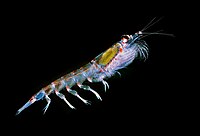Antarctic krill
Antarctic krill (Euphausia superba) is a species of krill that lives in the Antarctic waters of the Southern Ocean. They are shrimp-like and belong to the invertebrates.
| Antarctic krill | |
|---|---|

| |
| Scientific classification | |
| Kingdom: | |
| Phylum: | |
| Subphylum: | |
| Class: | |
| Order: | |
| Family: | |
| Genus: | |
| Species: | E. superba
|
| Binomial name | |
| Euphausia superba Dana, 1850
| |
They live in large groups, called swarms. Sometimes these swarms have a density of 10,000–30,000 individual animals per cubic meter.[1]
They feed directly on very small phytoplankton, so they can use the energy that the phytoplankton originally got from the sun in order to sustain their life in the open ocean.[2] They grow to a length of 6 cm, weigh up to 2 g, and can live for up to six years. They are a key species in the Antarctic ecosystem and are, in terms of biomass, probably the most successful animal species on the planet (approximately 500 million tonnes).[3]
In aquaria, krill have been observed to eat each other.
References
change- ↑ Hamner, W. M., Hamner, P. P., Strand, S. W., Gilmer, R. W. (1983). "Behavior of Antarctic Krill, Euphausia superba: Chemoreception, Feeding, Schooling and Molting". Science. 220 (4595): 433–435. doi:10.1126/science.220.4595.433. PMID 17831417. S2CID 22161686.
no
{{cite journal}}: CS1 maint: multiple names: authors list (link) - ↑ Kils, U., Klages, N (1979). "Der Krill". Naturwissenschaftliche Rundschau. 10: 397–402.
no
{{cite journal}}: CS1 maint: multiple names: authors list (link) - ↑ Nicol, S., Endo, Y. (1997). Fisheries Technical Paper 367: Krill Fisheries of the World. FAO. Archived from the original on 2006-05-14. Retrieved 2021-12-27.
{{cite book}}: CS1 maint: multiple names: authors list (link)
Further reading
change- Hempel, G.: The krill-dominated pelagic system of the Southern Ocean. Envir. Inter. 13, pp. 33 – 36; 1987.
- Hempel, G.: Life in the Antarctic sea ice zone. Polar Record 27(162); pp. 249 – 253; 1991
- Hempel, G.; Sherman, K.: Large marine ecosystems of the world: trends in exploitation, protection, and research. Elsevier, Amsterdam: Large marine ecosystems 12, 423 pp; 2003
- Nicol, S. & de la Mare, W. K. Ecosystem management and the Antarctic krill. American Scientist 81 (No. 1), pp. 36–47. Biol 9:129–135; 1993.
- Nicol, S.; Foster, J.: Recent trends in the fishery for Antarctic krill Archived 2006-01-18 at the Wayback Machine, Aquat. Living Resour. 16, pp. 42 – 45; 2003.
- Sahrhage, D.: Antarctic Krill Fisheries: Potential Resources and Ecological Concerns. In Caddy, J. F. (ed.): Marine Invertebrate Fisheries; their assessment and management; pp. 13 – 33. Wiley, 1989.
- Ikeda, T. (1984) The influence of feeding on the metabolic activity of Antarctic krill (Euphausia superba Dana). Polar Biology 3(1)
- Clarke, A. (1983) Towards an energy budget for krill: The physiology and biochemistry of Euphausia superba Dana. Polar Biology 2(2)
Other websites
change- Euphausia superba Archived 2006-03-19 at the Wayback Machine from MarineBio.
- "Virtual microscope" Archived 2002-12-18 at the Wayback Machine of Antarctic krill for an interactive tour of their morphology and behavior, along with other peer-reviewed information.
- "Krill fights for survival as sea ice melts" from the NASA's "Earth Observatory".
- "Antarctic Wildlife at Risk From Overfishing, Experts Say", from National Geographic News, August 5 2003.
- Diary Archived 2005-04-14 at the Wayback Machine of the RRS James Clark Ross, giving a popular introduction to the Antarctic krill.
- "Less krill for predators in the Southern Ocean" Archived 2005-04-14 at the Wayback Machine from the British Antarctic Survey. See also "Climate row touches blue whales", from the BBC, July 19 2001.
- A time to krill Archived 2005-10-23 at the Wayback Machine
- Extensive bibliography.
- Krill Count Project Archived 2012-05-21 at the Wayback Machine
- WIKIversity Lecture "Biology of Antarctica" Archived 2007-09-26 at the Wayback Machine